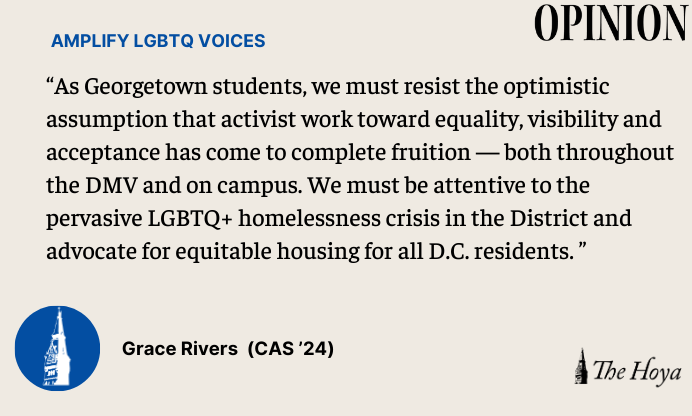Washington, D.C. has long been regarded as a safe haven for members of the LGBTQ+ community on account of its impressive queer population.
With 10% of residents self-identifying as LGBTQ+, the District’s percentage of queer residents is nearly triple the national average of 3.5%.
The District has also passed substantial legislation that protects LGBTQ+ people in employment and education, allows gender updates on identification documents, protects against conversion therapy and includes transgender health care in state Medicaid.
Yet, D.C.’s high concentration of LGBTQ+ people translates to an unfortunate overrepresentation of queer people among the city’s homeless population.
A staggering 40% of unhoused youth between the ages of 18 and 24 identify as LGBTQ+ in the District. Furthermore, Laura Zeilinger, the director of the D.C. department of human services, reported that 18% of unsheltered adults identify as members of the LGBTQ+ community.
Thus, while D.C. boasts a burgeoning LGBTQ+ population, the District simultaneously experiences heightened rates of homelessness among its queer demographic.
As Georgetown students, we must resist the optimistic assumption that activist work toward equality, visibility and acceptance has come to complete fruition — both throughout the DMV and on campus. We must be attentive to the pervasive LGBTQ+ homelessness crisis in the District and advocate for equitable housing for all D.C. residents.
The high rate of homelessness among the District’s LGBTQ+ residents is not merely coincidental. Rather, the LGBTQ+ homelessness population is a testament to the discrimination faced by this community and most acutely, the youth.
80% of queer youth experiencing homelessness were forced out of their homes, with 30% of these youth having been abused by their families, according to a report released by True Colors United, a nonprofit who works to combat youth homelessness in the United States.
Data from D.C., in particular, confirms that 20% of the LGBTQ+ population in the shelter system report a history of domestic violence.
Furthermore, this crisis is exacerbated for queer people of color.
Aside from issues of familial violence, LGBTQ+ people of color also experience housing discrimination in D.C., which increases their risk of homelessness. Black queer communities, like Dupont Circle, existed within the District long before the city’s renowned “gayborhoods.”
A national survey by the Center for American Progress revealed that 44% of LGBTQ+ people of color reported that discrimination impacted their ability to rent or purchase a home.
LGBTQ+ people of color in the DMV face heightened risks of experiencing housing discrimination on account of their race, gender identity and/or sexual orientation.
In addition, when LGBTQ+ people of color are unhoused, they are particularly vulnerable to violence. For instance, the DMV community was shaken after Zoe Spears, a 23-year-old trans woman experiencing homelessness, was shot and killed in 2019. Her tragic death exposed the need for homeless shelters that cater toward LGBTQ+ residents, namely trans people of color.
Regardless, it is important to acknowledge the steps D.C. has taken to mitigate homelessness among its queer population.
In 2013, a D.C. law set aside shelter space for LGBTQ+ youth and increased funding for homeless services by $1.3 million in 2015. More recently, institutions such as the Wanda Alston Foundation, which provides support to at-risk LGBTQ+ youth, have provided services and transitional housing for homeless queer youth.
Likewise, the first government-operated shelter for LGBTQ+ homeless individuals just opened in July 2022. However, these measures are not entirely sufficient, as they often allocate a set number of beds to queer homeless people or are underfunded.
Thus, with the expectation that the queer homeless population will continue to grow over time, more resources, intention and legislation must be allocated and enacted in order to effectively address the queer homeless population in the District.
As Georgetown students, we must be vocal in our support for such programs as those offered by the LGBTQ+ shelters, which provide essential occupation training, transitional housing, mental health and health care support. Acknowledging and discussing the problem in academic circles is perhaps the first means of combating it.
Ultimately, while the LGBTQ+ community continues to thrive in the District, we cannot leave its most vulnerable behind.
Grace Rivers is a senior in the College of Arts & Sciences. This is the second installment of her column, Amplify LGBTQ Voices.














